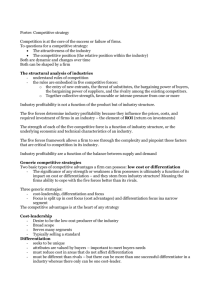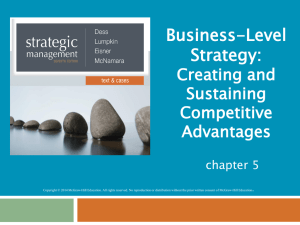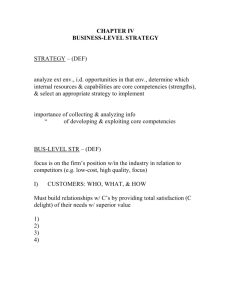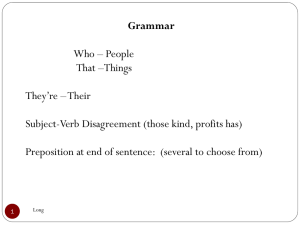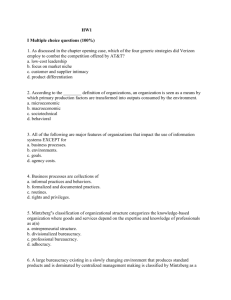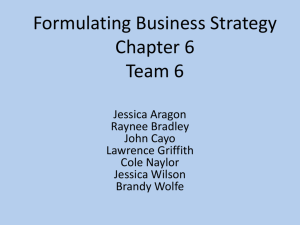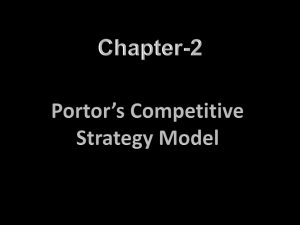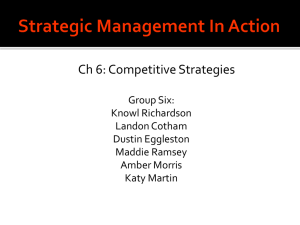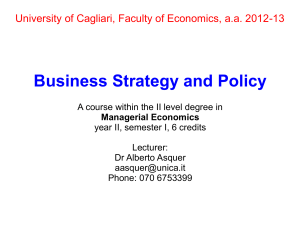Strategy A view from the top
advertisement
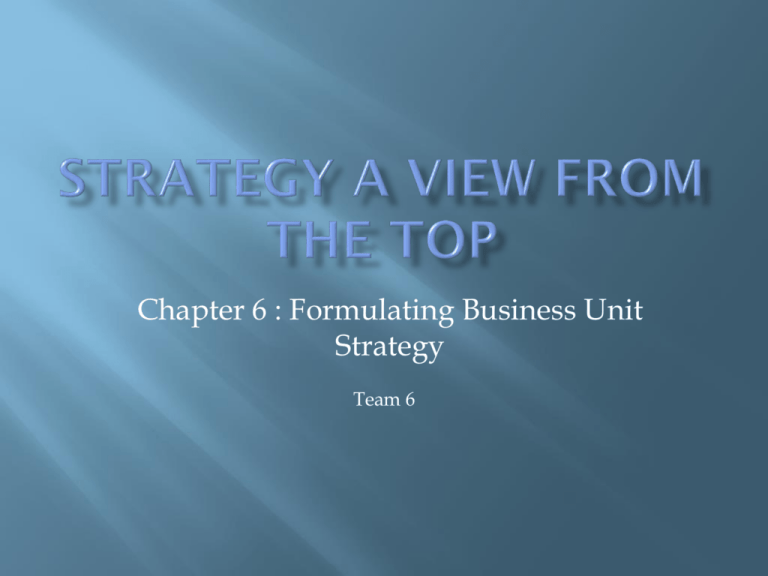
Chapter 6 : Formulating Business Unit Strategy Team 6 Involves creating a profitable competitive position for a business within a specific industry or market segment Often referred to as a competitive strategy Optimal strategies depend on many factors, including the nature of the industry; the company’s mission, goals, and objectives; its current position and core competencies; and major competitors’ strategic choices. Success is explained by two factors Attractiveness of the industry Industry characteristics are an important determinant of profit potential Good to Great argues that “a company does not need to be in a great industry to become a great company. Each good-to-great company built a fabulous economic engine, regardless of the industry.” Relative Position Two forms of sustainable competitive positioning are competitive advantage based on lower delivered cost and the ability to differentiate products or services. A study by the Harvard Business school to research relative profitability of different market strategies found the following: Market share is strongly related with ROI Product quality is key to market leadership Vertical integration can be beneficial later in the product life cycle ROI is positively correlated with market growth High investment and inventory levels tend to depress ROI Capacity use is critical for businesses with a high level of capital intensity 1) Analyzing the competitive environment With whom will we compete? What relative strengths do we have as a basis for creating a sustainable competitive advantage? 2) Anticipating key competitors’ actions Understanding how competitors will react to our competitive strategy 3) Generating strategic options Balancing opportunities and constraints to create options 4) Choosing among the alternatives Analysis of the long-term impact of different strategy options Competitive advantage is sustainable when current or new competitors are not able to imitate or supplant the advantage Often created by combining strengths Building competitive advantage is rooted in identifying, practicing, strengthening, and instilling leadership traits throughout the organization Value- perceived benefit that a buyer is willing to pay a firm for what the firm provides Value Chain- A model of the business process Divides the firm’s business process into component activities that add value Once a firm’s primary, support, and activity types are defined, Value Chain analysis assigns assets and operating costs to all value-creating activities Analyzing the value chains of competitors, customers, and suppliers can help a firm add value Firm Infrastructure Support Activities Human Resource Management Technology Development Procurement Inbound Operations Outbound Marketing Logistics Logistics and Sales Primary Activities Service It is important to identify the value that individual primary and support activities contribute beyond their costs The value chain can be used to shape responses to changing upstream and downstream market conditions through collaboration Physical value chain- represents the use of raw materials and labor to deliver a tangible product Virtual value chain- information flows underlying the physical activities evident within a firm Generic competitive strategic postures that apply to any business in any industry according to Porter Cost leaders charge less for goods and services and aim for a substantial share of the market Cost focus- only activities directly relevant to serving the well-defined market niche are undertaken A differentiation strategy is aimed at a broad, mass market and seeks to create uniqueness on an industry-wide basis Achieved through product design, brand image, technology, distribution, service, or a combination of these elements Strategic Advantage Strategic Target Uniqueness perceived Low-cost position by the customer Industry-wide Particular segment only Differentiation Overall Cost Leadership Focus Cost Leadership Ruthless devotion to minimizing costs through continuous improvement in manufacturing, process engineering, and other cost-reducing strategies Tight control of the organizational structure is essential Differentiation The company offers something unique that is valuable Offers a value other than low price Most successful differentiation strategies involve multiple sources of differentiation Cost leaders Technological change that can nullify past investments in scale economies New entrants from other parts of the world can take advantage of even lower factor costs Differentiation The biggest challenge is imitators Imitation narrows actual and perceived value Created a sustainable competitive advantage by committing to its low-cost, speed based business model combined with new principles Stuck to its business model of making PCs cheap and never countered the innovative and aggressive moves of its competitors The cost-leadership strategy produced great sales when market demand was high, but it kept Dell from maintaining its growth path when sufficient sales could only be found in new product market segments where differentiation was demanded Generic strategies aren’t always viable, but strategies that combine the elements of cost leadership, differentiation, and flexibility are better able to meet customer needs It is argued that differentiation and low-cost are not mutually exclusive; they can exist within the total quality management As discussed in Blue Ocean Strategy, “Value innovation is created in the region where a company’s actions favorably affect its cost structure and its value proposition to buyers.” The pursuit of a pure generic strategy will not sustain a competitive advantage in hypercompetitive environments Different ways companies can create value for customers. Specifically three generic strategies: Product Leadership Operational Excellence Customer Intimacy Produce a continuous stream of state-of-the-art products and services Encourage innovation Have a risk-oriented management style Recognition that the company’s success lies in its talented design people and those who support them Recognition of the need to educate and lead the market regarding the use and benefits of new products Approach aimed at better production and delivery mechanisms Example: Starwood Hotel and Resorts Decided to stylishly renovate its underperforming hotels and focus on doing and presenting everything it already did much better Restored a reputation for reliability, value, and consistency With a focus on operational excellence, Starwood led Marriott and Hilton in North American revenue per available room. Concentrates on building customer loyalty Example: Home Depot Changed daily operations to provide a more shopper-friendly store atmosphere Allows employees to focus on customer service and sales The second initiative involves home improvement classes taught at its stores Customer intimacy is enhanced when professionals teach customers how to buy and install the proper material and construction equipment Strategic Focus Work Environment Employee Competencies Customer intimacy Values-driven, dynamic, challenging, informal, service-oriented, qualitative, employee as customer, “whatever it takes” Relationship-building, listening, rapid problemsolving, independent action, initiative, collaboration, quality-focused Operational excellence Predictable, measurable, hierarchical, cost-conscious, team-based, formal Process control, continuous improvement, teamwork, analysis, financial/operational understanding Product leadership Experimental, learningfocused, technical, informal, fast-paced, resource-rich Information sharing, creativity, group problem solving, breakthrough thinking, artistic, visionary Adrian Slywotzky and David Morrison have identified business models/designs that generate profits in a unique way: Customer development/Customer solutions profit model Finds ways to improve their customers’ economics and ways to improve customers’ processes Product pyramid profit model Company offers a number of variations including lowpriced, high-volume products and high-priced, low volume products Multicomponent System profit model Switchboard profit model Businesses that are characterized by a system that consists of component that generate substantially different levels of profitability Creates a high-value intermediary that concentrates the multiple connection pathways through one point, reducing costs Time profit model Speed is the key to profitability and constant innovation is essential Blockbuster profit model Profitability is driven by a few great product successes Invest in a few projects rather than in a variety Profit multiplier profit model For businesses with strong consumer brands Entrepreneurial profit model Stresses that diseconomies of scale can exist Small can be beautiful Specialization profit model Installed base profit model Stresses growth through sequenced specialization Established user base subsequently buys the company’s brand of consumables or follow-on products De Facto standard profit model When the instilled base model becomes the de facto standard that governs competitive behavior in the industry

